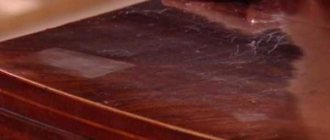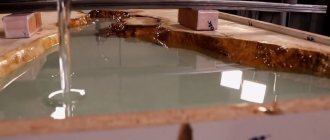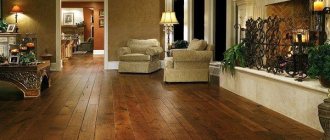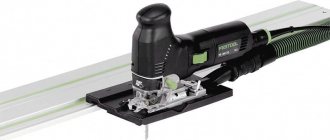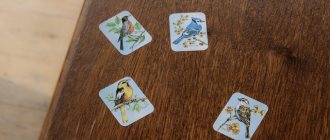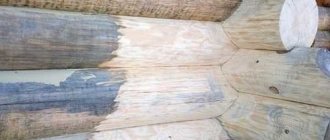Wooden boards are a popular construction and decorative material. But very often they have to be cleaned of resin.
There are several effective ways to help achieve the desired result. These include mechanical and chemical cleaning.
When choosing a suitable folk or professional remedy, you should follow all the rules of use and prohibitions.
We will tell you more about how and how to remove resin from a wooden board (for example, pine) in the article.
How to remove resin in a steam room
Steam room in the bathhouse, incl.
shelves, built from coniferous wood and resin exudes from the boards. How can you fix such a bathhouse? What can be done? Resin usually comes out of knots, which is where you have to dance))). If it is possible to replace shelf boards with knots with boards without knots, then try to do this, otherwise sitting on such a shelf will be quite uncomfortable and nothing else has been invented yet. The resin will flow out for a very long time. As for the walls, I won’t suggest changing them, it would be very troublesome. You can try to drill out the knots from which the resin is flowing with a feather drill and hammer a chip into this place and sand it. I think the problem will be solved.
I sympathize, I am familiar with this problem and this problem will last for a long time. The resin will be released, depending on the thickness of the boards, for a long time, several years. If it is not possible to change the casing, then get ready for righteous labor after the bathhouse. Once the bathhouse has cooled down, carry out a major inspection of the bathhouse, scraping off all the droplets of resin that have emerged. You can rub with turpentine, acetone, solvent, but it all stinks; using a knife is easier and faster and there is no smell. You will have to frolic like this for 2 years, but if you heat the sauna often and clean it after each fire, then maybe the resin will come out faster. It is better to heat the sauna high, so the resin comes out faster. Resin, when the bathhouse is heated, sticks and burns, so it is better to make several temporary removable lattices of linden, aspen or birch on the shelves and floor so as not to stick and burn. When cleaning the resin, remove the gratings and then put them back in place. Resin will not last forever, sooner or later it will end up in the boards, but if you don’t fight it, it completely spoils the impression of the bathhouse.
The formation of resin in a bath is a natural process. When heated, coniferous wood begins to release this substance to the surface. Sooner or later, every bathhouse owner encounters this phenomenon. What options are there to get rid of this problem?
Wood bleaching. Resin removal of wood
Pine wood, like other coniferous trees, is permeated with resin channels, from which resin is released. Deresining wood, which is often combined with bleaching, is carried out so that over time the resin does not appear on the surface of the product.
Almost always, carpenters ignore these procedures - they are quite labor-intensive and time-consuming. But over time, resin begins to release from the wooden product and even from the veneer, destroying the paint or varnish coating. Therefore, if you are doing it for yourself, do not be lazy, use de-resining of coniferous boards or veneer.
Warming up
The method is suitable for newly built baths. In order to remove resin from new boards, the steam room must be heated to the highest possible temperature.
The optimal incandescent room temperature is 150 degrees.
Under such conditions, the resin begins to actively release from the wood, after which it must be scraped off manually or using a solvent.
Method No. 4: processing with a router or drill
One of the best ways to eliminate resin stains is to combat the “bags” in which the substance is formed. To do this you will need a drill or router. The action algorithm is as follows:
- After heating, the beginning of resin streaks are found in the boards.
- These areas are drilled out using a milling machine or drill.
- Patches are prepared from similar wood.
- Take the sealant and fill the area into which the patch is stuck.
You can use any glue that is resistant to high humidity, intense heat and temperature changes.
Round router bit for drilling out resin Source blingfeel.com
Scraping
In order to melt the caked formation, you will need a soldering iron, which must be used to burn the damaged area. Once the resin is in liquid form, it can be easily scraped off. It is best to use a spatula for this purpose.
Any of the proposed methods will help the owner of the bathhouse get rid of tar stains in the shortest possible time.
Share on social media networks:
The interior, made of natural wood, looks very solid, presentable, soft and pleasant. Coniferous material is especially valuable, which also, during operation, contributes to the natural health of all residents of the house. But there is one problem that arises when laying coniferous wood - how to get rid of resin on the boards, which must be solved correctly. How to remove resin from wood in a pine bath or steam room? This is exactly what this article will be about.
Video material
When giving preference to coniferous boards, remember that you will not be able to completely get rid of resin on the boards. It can appear at any moment, the most unexpected for you. But this is actually not such a global problem, because the “resin” can be removed, and the beauty, environmental friendliness and benefits of such wood cannot be compared with any modern plastic or other material. Let your home be filled with only the pleasant aroma of pine needles and always look cozy. And now you know how to deal with minor resin problems.
Why remove resin?
Coniferous wood species such as pine, spruce, and larch are extremely beautiful, but they emit natural resins not only after cutting, but also during growth. This resin is a very viscous, fluid substance, so the process of interior finishing becomes significantly more complicated, because:
- The boards where the resin leaks out become extremely sticky and quickly adhere to any tools or materials they come into contact with.
- Typically, the places where the “resin” leaks out look somewhat darker than the entire board, so a uniform coating cannot be achieved.
- It is impossible to perform staining while the substance is leaking, and it is also unprofitable. Paint or varnish will not harden on resin stains, and accordingly, convex areas of the coating, unprotected from the harmful effects of moisture, will remain, standing out with their color.
REPAIR OF RESIN POCKETS
The problem was solved mechanically: a section of wood along with a resin pocket was cut out to a depth of 5 mm. Then the recess was sealed with a so-called boat - an insert made of dry, non-resinized wood, installed with glue. We made all this by hand with single resin pockets.
After sealing the resin pockets, we began to eliminate the resins. These are volumetric defects, and the tarred areas must be repaired with a continuous layer of clean wood. To do this, the front sections of the frames with tars had to be cut to a depth of 3-5 mm using wide chisels and sandpaper.
Inserts made of healthy wood were tightly fitted and glued onto these cleaned areas. After the glue had dried, the window frames were sanded and thoroughly treated with acetone to remove any residual resin, and then the areas of the frames to be repaired were thoroughly washed with hot water and soap.
Now we could begin to restore the paint layer. The areas to be repaired were plastered with finely dispersed putty. Then they carefully sanded, primed and painted in two layers.
How to remove resin from a board?
In order to correctly prepare all the elements for laying the floor, wall covering or ceiling, you need to properly get rid of the resin on the boards. This can be done in several ways.
Mechanical removal
In this case, in order to remove the resin from the boards, you must wait until the fluid mass has completely hardened. Then, armed with a knife, remove each piece by hand.
Important! After removing all unwanted deposits, it is necessary to sand the surface of the wood with sandpaper or a special tool.
Solvents
To dissolve the “resin”, you can also use available chemicals. The following tools are suitable for this purpose:
- alcohol;
- White Spirit;
- turpentine;
- refined gasoline;
- acetone;
- nitro solvent.
Important! The use of any of these solvents does not affect the structure and shade of coniferous wood. But when using it, it is advisable to protect yourself with gloves and a respirator so that caustic volatile vapors do not provoke irritation of the skin and mucous membranes.
What not to do with a resin trace
Before choosing how to remove tree sap from clothes, you should consider some important factors, otherwise you may accidentally damage the item irrevocably.
Before using one of the suggested cleaning methods, you need to scrape off the resin itself. All the proposed options are aimed at getting rid of its traces, but none of them will help get rid of it completely, without preliminary cleaning.
Brightly colored items made from delicate materials should not be cleaned with alcohol or any acids, because they can discolor the fabric at the point of contact. Vinegar, even diluted with water, should not be used on silk fabric. Strong alkaline solvents and especially bleaches are safe to use only for white things, otherwise the color will begin to peel off. Turpentine or gasoline are only suitable for rough fabrics
It is rational to use them for jackets, trousers and other things that do not require careful handling. They are also most suitable for hiking clothing, which is made from durable materials - gentle products may be ineffective
To prevent the stain from spreading further during the cleaning process, you can moisten the cloth around it with plain water or sprinkle it with starch/talcum powder. The directions of movements when cleaning should be from the edge to the center, and not vice versa, otherwise the dirt will spread and be firmly absorbed. It is advisable to clean from the inside out and move to the front side.
Before doing this, make sure that the fabric is not discolored. It is not advisable to leave the product on for longer than the recommended time, otherwise it may begin to corrode the fabric.
Since resin can be dissolved using different methods, the item stained with it will not be damaged forever
It is only important to know which methods are suitable for a particular material, as well as to have the necessary tools at hand. Even for delicate fabrics there are safe options with which the item will return to its normal state. In any case, you shouldn’t worry and throw away an item if there is a chance to save it
There are many ways to get rid of tar stains, and one of them will definitely help.
In any case, you shouldn’t worry and throw away the item if there is a chance to save it. There are many ways to get rid of tar stains, and one of them will definitely help.
Safe recipes
In order not to damage the wood either by mechanical or chemical influence, or in the case of a small amount of “resin”, use the following means to get rid of resin on the boards:
- 25 g of wood or any liquid soap mixed with 50 ml of ammonia and 1 liter of hot water;
- acetic solution of concentrated acid and water in a ratio of 1:50.
Important! The latter remedy is also good for removing alkali residues after using any other substance or solution in order to get rid of resin on boards. It helps a lot, including when you are washing finished walls and you need to remove cleaning residue from the joints of the crowns.
Other ways and means
You can also get rid of resin on boards using traditional methods, which involve using available kitchen and pharmacy solutions and powders.
The following methods effectively help solve the problem:
- Ammonia or ammonia solution. This product is diluted with acetone in a ratio of 2:1. Apply to the surface with rubbing movements until foam forms. Remains of foam and resin are removed after 20 minutes with a clean damp cloth.
- Potash and soda in equal proportions (50 g each). Both substances are mixed and poured into 1 liter of hot water. To enhance the effect, you can add 250 ml of acetone.
- Caustic soda. It is dissolved in half a liter of cold water. You can also add 250 ml of a solvent such as acetone.
Important! Any of these products can only be applied to a sanded, but not painted surface. Otherwise, the acetone will dissolve the paint and the finished finish will not look the most attractive.
Stages
If the master has chosen pine as a material for the floor or other elements of the room, then you need to take into account the properties of this wood when processing it with stain and varnish. The steps for proper operation are:
- Buying high-quality “correct” boards.
- Grinding.
- Primer.
- Impregnation with stain.
Many carpenters and woodworkers love pine because it is easy to work with, light weight, and low cost. In addition, this wood is available everywhere.
When finished with transparent materials, the pine surface seems to radiate warm sunlight. This effect is rarely found in other breeds.
Because of this drawback, you should not refuse to process such material. You can tint pine boards evenly if you know the technology and how to do it correctly. This will require only a few simple steps and a little more time to prepare the wood.
Preparing for cleaning
Having discovered a dark tar stain on the leg or sleeve of a blouse, the first thing you need to do is remember how it could have appeared. If trouble occurs after a walk in a park planted with coniferous trees, or while picking mushrooms in a pine forest, then we are talking about tree resin. It’s another matter if the stain appeared during repairs or after going to a construction site. In this case, we can assume that the resin is epoxy.
Resin type – wood (natural) or epoxy
There are two types of resins: natural, or wood, and synthetic. But they are all characterized by incredible stickiness, the ability to quickly penetrate the fabric fibers and glue them together.
Before cleaning begins, it is necessary to correctly determine the type of resin.
- Tree resin (tar) is a viscous, oily liquid of a dark brown color. It is formed as a result of the hardening of the sap of some trees. Resin is produced by pine trees, spruce trees, larches, poplar buds, thuja and other plants.
- Epoxy resin is a representative of synthetic substances, as it is produced chemically. Such resins are widely used in households, construction, and manufacturing. Epoxy exhibits its binding properties only when combined with a hardener and is resistant to acids and alkalis.
Vegetable stains are much easier to remove than stains caused by epoxy resin.
Fabric material
To select a cleaning product, it is important to know what fabric the stained jacket or blouse is made of. Otherwise, a hole may form in place of the stain, the paint may peel off, or some other trouble may occur.
The composition of the material and methods of caring for the product are indicated on the label. If the information is erased or the label is cut off immediately after purchase, you should follow these rules:
- Wool and natural silk do not tolerate exposure to strong alkaline solutions. To clean the surface of these materials from resin, ammonia or a mixture of starch (1 tsp) and turpentine (5-6 drops) is used.
- Turpentine or acetone will help remove the viscous substance from cotton fabric. When the resin has dissolved, wipe the contaminated area with alcohol and rinse with water.
- Acetate silk and bologna fabric are treated with purified gasoline. Acetic acid and acetone should not be used to process these materials.
- Nylon and nylon do not tolerate treatment with gasoline, benzene and alkaline solutions. Resin stains from these materials must be removed with warm water and laundry soap.
- Leather items cannot withstand exposure to solvents. For them, the best cleaning agent is vegetable oil.
- Jeans stained with wood resin can be easily cleaned with turpentine and ammonia, using them in equal quantities. Potato starch is added to the solution to obtain a thick paste, and the area of contamination is coated. After drying, the remaining paste is brushed off and the pants are washed.
- A jacket made of membrane fabric can be scrubbed using turpentine and laundry soap. Turpentine is diluted with water in a ratio of 1:2, grated soap is added to the mixture and the soiled part of the clothing is washed.
Fresh or old stain?
A fresh stain that has just appeared is always easier to remove than an old one. Therefore, as soon as a resin blot is discovered, you must immediately begin cleaning:
- Use a paper napkin or handkerchief to blot the resin, trying to collect a thick mass from the surface of the material.
- Do not wash, much less soak, the product. This will not help the matter; the stain will spread even more.
- If you don't have a stain remover on hand, you can try to get rid of the stain using vegetable oil. In case of failure, you will have to start processing with other substances suitable for the composition of the fabric.
Fresh stains usually have a blurred outline and are darker in color than the fabric. Old stains have a clear outline, they are lighter than the fabric, and appear both from the face and from the inside.
How to prepare things for stain removal?
Before applying the cleaning agent, the affected product must be prepared as follows:
- Shake out the dust and clean the surface of the clothing with a brush.
- Test the durability of the fabric in an inconspicuous area, such as a pocket or side inseam.
- Place the product on a table or floor and place a board wrapped in cotton material under the stain.
- If the product has a lining, it is peeled off in advance so that it is possible to place a board between the top and the lining fabric.
- The fabric around the stain is moistened with water. This will prevent the formation of divorces.
Useful tips
In each case, you will have to use a specific tool. You can combine some removal methods.
But before experimenting, we recommend that you familiarize yourself with the following tips:
- Products made of suede and fur are best cleaned with alcohol;
- Woolen fabrics can be washed well with turpentine;
- When cleaning silk, do not use acetone or nail polish remover. These substances can destroy tissue;
- You can use bleach to clean white items;
- Do not clean synthetic fabrics with gasoline;
- Exposure to alcohol-containing substances may destroy the color of the fabric. Try using these substances on inconspicuous places first;
- To prevent the stain from spreading over the surface, sprinkle talc or starch around the perimeter;
- It is better to use cotton swabs to apply the product. You can also drip liquid products onto the stain using a pipette;
- Before treating a stain, place a napkin or other cloth under it. This will prevent sweat from contaminating the surface with the item;
- If cleaning involves flammable agents, perform the work away from open flames.
Source: kak-otteret.ru
Solvent
To remove tree resin, a special deck board solvent is also used. Simply apply the stripper using a brush to the affected areas in the direction of the wood grain. Let the product soak in for ten to fifteen minutes, then clean off the resin. As a bonus, most solvents wash off easily with water, so no chemicals will harm the environment.
As an alternative to chemical tar removal, many people prefer to use undissolved oil soap. The resin is removed with a mop or the solution is poured directly onto the affected area. As with other tree resin cleaners, allow the product to saturate the surface for about fifteen minutes, after which the area can be washed along the grain of the wood and wiped with a clean, dry cloth. Since it is an oil-based solution, it will soften the sap, making it easier to remove.
When the walls are already covered
If the resin began to appear from the boards after they were laid on the walls, you are unlikely to have the desire to spend a lot of time precisely removing each piece of “resin” with solvents or a knife.
In this case, you can burn through all the places where pine sap is formed with a blowtorch, then sanding them with sandpaper of a suitable grain size.
The high content of natural resins, due to which coniferous wood is less vulnerable to rot, mold and bark beetles, determines the popularity of using these species in construction. However, this property is also a disadvantage. Softwoods, especially freshly cut ones, tend to release resin, which makes it very difficult to treat the surface of the wood, since the resin is very sticky to everything that comes into contact with it.
In addition, the resin area darkens. Such unexpected releases of resin (resin) force additional work to remove this resin from the surface. Painting a place with resin does not work well, and sometimes a layer of varnish is not applied at all.
Resin is a heterogeneous mixture of resin acids, fatty acids, esters of these acids, sterols, alcohols, waxes and resenes. The resin content in coniferous wood is associated with the physiological processes of their respiration and growth. It has been experimentally proven that the content of the essential extract is maximum in autumn-winter and minimum in spring-summer, since the resin is consumed during intensive plant growth.
Here are several ways to eliminate resin drips on the finished product.
Removal of tar is carried out only after grinding the surface. This is due to the fact that this process is carried out only to a depth of 1-2 mm. Upon subsequent heating, even after applying the paint coating, resin may appear.
Carrying out resin removal using chemicals does not fully guarantee that resin will not appear on the coating subsequently.
- An effective means for removing tar is a mixture consisting of 25 g of liquid soap dissolved in 1 liter of hot water. Add 50 ml of ammonia to the resulting solution while stirring.
1. Use of solvents.
The following are used as resin solvents:
- turpentine;
- alcohol;
- refined gasoline or white spirit;
- nitro solvent.
- acetone;
These products quickly dissolve the resin and easily evaporate, but do not affect the appearance of the wood and, most importantly, do not leave any signs of processing. Using the listed means, large surface areas of timber are treated. The final cleaning procedure is rinsing with ordinary warm water.
2. Use of alkaline solutions.
An alkaline composition can be used to remove resin from the surface of the timber. Alkalis are used for degumming large surfaces. From available means, you can use solutions of soda and potash to remove resin and resin from the surface of the timber. The mixture is prepared as follows:
Dissolve 50 g of potash or 50 g of soda in 1 liter of hot water and add 250 ml of acetone;
25 g of caustic soda per 0.5 liter of cold water and 250 ml of acetone.
These solutions are used to remove resin from the surface before processing; they cannot be used on already painted parts, not on finished products. It is important to remember that it is very difficult to remove alkalis from the grooves between the crowns of a log house. Remaining solutions destroy the paint coating when crystals form.
3. Use of ammonia-containing solutions.
Ammonia is one of the effective means used to dissolve resin. Its distinctive feature is the absence of surface treatment marks. It is diluted with acetone, applied 2-3 times to resin drips and rubbed with a brush or brush until foam forms. After this, after 20 minutes, wash off the foam with water.
It is better to treat tars with any alkalis while hot. Alkalies must be applied with any brushes other than metal brushes.
The resulting foam is rubbed over the surface and the saponified resin residues are washed off with plenty of water. To completely remove the remaining alkali remaining in the grooves between the rims, it is washed with a solution of acetic acid in a ratio of 1:50 (the acid is poured into water, and not vice versa).
The acetic acid solution is applied with a sponge; hands should be protected with rubber gloves. Then the entire surface is washed off with water. Re-application of paint and varnish coatings is carried out only after the wood has completely dried.


